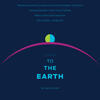Listen to the Earth by James Grant
Temple University Concert Choir
Commonwealth Youth Choir Trebles
Concert Choir Chamber Orchestra
Marcus DeLoach, baritone
Paul Rardin, conductor
Commissioned to mark the 50th Anniversary of Earth Day, Listen to the Earth hitches a ride aboard NASA’s historic July 1969 Apollo 11 mission to the moon. The music is scored for baritone solo, youth chorus, mixed chorus and orchestra or chamber orchestra.
The texts come from three sources: the NASA transcript of communications between Houston Mission Control and Apollo 11 Mission Commander Neil Armstrong; the United Nations Environmental Sabbath Program; and original texts sung by the baritone soloist, written by the composer and inspired by the writings of Mercury, Gemini, Apollo and Space Shuttle astronauts, and astronomer Carl Sagan.
As the piece opens we are at T-minus 15 seconds atop Apollo 11’s 30-story high rocket, seconds away from starting the ignition sequence of its massive Saturn V boosters—with “exhilaration coursing through our veins,” we barely have time to secure our safety harnesses as the thunderous launch “lifts us into the endless mystery of space.”
As Apollo 11 clears the launch tower and its ascent from Earth accelerates, we hear the rapid-fire back-and-forth between Houston’s Mission Control (the Chorus) and Apollo 11’s Mission Commander, Neil Armstrong (baritone solo). Systems are checked, flight abort modes come and go, and the second stage is ignited.
Upon reaching Earth Orbit Phase, our Astronaut catches his first glimpse of Earth from space and marvels at the majesty of this “living, breathing, precious four-and-a-half-billion-year-old miracle.”
Houston initiates the Translunar Phase of the mission, which releases Apollo 11 from Earth orbit and sets it on its lunar trajectory: “You are GO for translunar injection!”— and Apollo 11 commences its 3-day coast through space toward the moon.
Our Astronaut becomes increasingly introspective as he views Earth slowly receding, and he begins to comprehend with emphatic clarity that “this beacon of blue and brown, green and white, holds the summary of my life.” An impassioned litany between the Astronaut and the combined Youth and Mixed Choruses expands in scope and intensity. Now in lunar orbit, Apollo 11 gets the call from Houston: “Apollo 11, Houston. We’re go for undocking. Over.” The Lunar Module (Eagle) detaches from the Command Module, and our Astronaut reports: “Eagle is undocked. The Eagle has wings.” The descent to the lunar surface has begun.
Eagle lands on the moon; and now, our Astronaut is “standing in cosmic dust, orbiting a rotating planet orbiting a distant star.” Gazing in awe at Earth from the lunar surface, he sees and understands for the first time what Earth truly is: “a fragile, defenseless sphere floating gracefully through space and time.”
If only we all could stand with our Astronaut on the lunar surface and see Earth from one- quarter million miles away. From this vantage point we surely would comprehend just how vulnerable, isolated and tentative our one and only home truly is, and that Earth’s intricate, delicately balanced ecosystems are indeed a miracle. We surely would understand that we must—we absolutely must—commit to nurturing and caring for Earth, every moment of every day, in every way possible, just as she always has cared for us.
--Program note by James Grant

